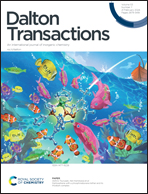Cu(ii) flavonoids as potential photochemotherapeutic agents†
Abstract
Flavonoids, naturally derived polyphenolic compounds, have received significant attention due to their remarkable biochemical properties that offer substantial health benefits to humans. In this work, a series of six Cu(II) flavonoid complexes of the formulation [Cu(L1)(L2)](ClO4) where L1 is 3-hydroxy flavone (HF1, 1 and 4), 4-fluoro-3-hydroxy flavone (HF2, 2 and 5), and 2,6-difluoro-3-hydroxy flavone (HF3, 3 and 6); L2 is 1,10-phenanthroline (phen, 1–3) and 2-(anthracen-1-yl)-1H-imidazo[4,5-f][1,10]phenanthroline (aip, 4–6) were successfully synthesized, fully characterized and also evaluated for their in vitro photo-triggered cytotoxicity in cancer cells. The single-crystal X-ray diffraction structure of complex 2 shows square pyramidal geometry around the Cu(II) center. The complexes 1–6 showed quasi-reversible cyclic voltammetric responses for the Cu(II)/Cu(I) couple at ∼−0.230 V with a very large ΔEp value of ∼350–480 mV against the Ag/AgCl reference electrode in DMF–0.1 M tetrabutylammonium perchlorate (TBAP) at a scan rate of 50 mV s−1. The complexes were found to have considerable binding propensity for human serum albumin (HSA) and calf thymus DNA (ct-DNA). The complexes displayed remarkable dose-dependent photocytotoxicity in visible light (400–700 nm) in both A549 (human lung cancer) and MCF-7 (human breast cancer) cell lines while remaining significantly less toxic in darkness. They were found to be much less toxic to HPL1D (immortalized human peripheral lung epithelial) normal cells compared to A549 and MCF-7 cancer cells. Upon exposure to visible light, they generate reactive oxygen species, which are thought to be the main contributors to the death of cancer cells. In the presence of visible light, the complexes predominantly elicit an apoptotic mode of cell death. Complex 6 preferentially localizes in the mitochondria of A549 cells.



 Please wait while we load your content...
Please wait while we load your content...